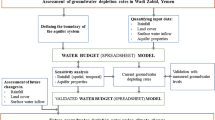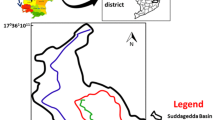Abstract
Groundwater sustainability is one of the most critical issues to the State of Punjab, India. In this research, a numerical groundwater flow model (MODFLOW) was employed to simulate flow and groundwater levels in the Sirhind Canal Tract of Punjab between 1998 and 2030. Historical groundwater patterns were calibrated using reported groundwater data from 1998 to 2013 for aquifer parameters viz. hydraulic conductivity and specific yield. Thereafter, calibrated flow simulated model was validated for the years 2013–2018. Twelve possible strategies, including three irrigation conditions and four pumping scenarios, were postulated to evaluate the performance of groundwater resources through to 2030. During the study, it was found that if current groundwater abstraction continues there will be further steep decline of 21.49 m in groundwater level by 2030. Findings also suggest that canal water supplies will be beneficial to reverse groundwater level decline and help to increase the water level by 11% above that in year 2018. The projected increases in water level will reduce energy demand leading to reduced CO2 emissions of approximately 966.6 thousand tonnes by 2030.








Similar content being viewed by others
Change history
16 April 2024
A Correction to this paper has been published: https://doi.org/10.1007/s40808-024-02002-6
References
Aggarwal PK, Joshi PK, Ingram JSI, Gupta RK (2004) Adapting food systems of the Indo-Gangetic plains to global environmental change: key information needs to improve policy formulation. Environ Sci Policy 7(6):487–498
Aggarwal R, Sondhi SK, Kaushal MP (2005) Integrated simulation-optimization model for groundwater management in Punjab, India. Int Agric Eng J 14(4):187–192
Aivazidou E, Tsolakis N, Vlachos D, Iakovou E (2018) A water footprint management framework for supply chains under green market behaviour. J Clean Prod 197:592–606
Barbosa EAA, Matsura EE, dos Santos LNS, Gonçalves IZ, Nazário AA, Feitosa DRC (2017) Water footprint of sugarcane irrigated with treated sewage and freshwater under subsurface drip irrigation, in Southeast Brazil. J Clean Prod 153:448–456
Bouqdaoui KE, Aachib M (2019) Simulations of some scenarios of management and restoration of Berrechid aquifer (Morocco). Int J Eng Adv Technol 8(4):1735–1741
Bushira KM, Ramirez Hernandez J, Sheng Z (2017) Surface and groundwater flow modeling for calibrating steady state using MODFLOW in Colorado River Delta Baja California Mexico. Model Earth Syst Environ 3(2):815–824. https://doi.org/10.1007/s40808-017-0337-5
Candela L, Fabregat S, Josa A, Suriol J, Vigués N, Mas J (2007) Assessment of soil and groundwater impacts by treated urban wastewater reuse. A case study: application in a golf course (Girona, Spain). Sci Total Environ 374(1):26–35
Central Ground Water Board (2017) Annual report 2015–16. Faridabad: Central Ground Water Board, Ministry of Water Resources, River Development & Ganga Rejuvenation, Government of India. Available at: http://cgwb.gov.in/Annual-Reports/Annual%20Report%202015-16.pdf (accessed 18 Jan 2020).
Chakraborty S, Maity PK, Das S (2020) Investigation, simulation, identification and prediction of groundwater levels in coastal areas of Purba Midnapur, India, using MODFLOW. Environ Dev Sustain 22:3805–3837
Chang FJ, Huang CW, Cheng ST, Chang LC (2017) Conservation of groundwater from over-exploitation—Scientific analyses for groundwater resources management. Sci Total Environ 598:828–38
Cheng P, Jin Q, Jiang H, Hua M, Ye Z (2020) Efficiency assessment of rural domestic sewage treatment facilities by a slacked-based DEA model. J Clean Prod 267: 122111
Dhillon M, Kaur S, Sood A, Aggarwal R (2018) Estimation of carbon emissions from groundwater pumping in central Punjab. Carbon Manag 9(4):425–435
Doherty J (2016) PEST model-independent parameter estimation user manual Part I: PEST, SENSAN and global optimisers. PEST model-independent parameter estimation & uncertainty analysis. Available at: http://www.pesthomepage.org/Downloads.php. (accessed 18 Jan 2020).
Eltarabily MG, Negm AM, Yoshimura C, Takemura J (2018) Groundwater modeling in agricultural watershed under different recharge and discharge scenarios for Quaternary aquifer eastern Nile Delta, Egypt. Environ Model Asses 23:289–308
ESOPB (2020) 2019 Statistical Abstract of Punjab. Economic Adviser to Government, Punjab. https://www.esopb.gov.in/Static/PDF/Abstract2019.pdf. (accessed 25 Apr 2020).
Esteban E, Dinar A (2013) Modeling sustainable groundwater management: packaging and sequencing of policy interventions. J Environ Manage 119:93–102
FAO (2017) Water for Sustainable Food and Agriculture
Glass J, Rico DAV, Stefan C, Nga TTV (2018) Simulation of the impact of managed aquifer recharge on the groundwater system in Hanoi. Vietnam Hydrogeol J 26(7):2427–2442
Gorelick SM, Zheng C (2015) Global change and the groundwater management challenge. Water Resour Res 51(5):3031–51
Hira GS (2009) Water management in Northern States and the food security of India. J Crop Improv 23(2):136–157
Hoogesteger J, Wester P (2015) Intensive groundwater use and (in)equity: processes and governance challenges. Environ Sci Policy 51:117–124
Hu Y, Moiwo JP, Yang Y, Han S, Yang Y (2010) Agricultural water-saving and sustainable groundwater management in Shijiazhuang Irrigation District, North China Plain. J Hydrol 393(3–4):219–232
Kashaigili JJ, Kadigi RM, Sokile CS, Mahoo HF (2003) Constraints and potential for efficient inter-sectoral water allocations in Tanzania. Phys Chem Earth 28(20–27):839–851
Kaur N (2019) Impact of climate change on groundwater behaviour in Sirhind Canal Tract of Punjab: Doctoral dissertation. Ludhiana: Punjab Agricultural University
Kaur S, Aggarwal R, Soni A (2011) Study of water-table behaviour for the Indian Punjab using GIS. Water Sci Technol 63(8):1574–1581
Kaur S, Jalota SK, Singh KG, Lubana PPS, Aggarwal R (2015) Assessing climate change impact on root-zone water balance and groundwater levels. J Water Clim Change 6(3):436–448
Kaur S, Aggarwal R, Lal R (2016) Assessment and mitigation of greenhouse gas emissions from groundwater irrigation. Irrig Drain 65(5):762–770
Khan HF, Yang YCE, Ringler C, Wi S, Cheema MJM, Basharat M (2017) Guiding groundwater policy in the Indus Basin of Pakistan using a physically based groundwater model. J Water Resour Plan Manag 143(3):05016014
Khosa MK, Sekhon BS, Mavi MS, Benipal DS, Benbi DK (2012) Performance of target yield based fertiliser prescription equations in rice-wheat cropping system in Punjab. Ind J Fertilisers 8(2):14–18
Kori SM, Qureshi AL, Lashari BK, Memon NA (2013) Optimum strategies of groundwater pumping regime under scavenger tubewells in lower Indus basin, Sindh, Pakistan. Int Water Technol J 3:138–145
Li Z, Chen X, Liu W, Si B (2017) Determination of groundwater recharge mechanism in the deep loessial unsaturated zone by environmental tracers. Sci Total Environ 586:827–835
Liu W, Bailey RT, Andersen HE, Jeppesen E, Park S, Thodsen H, Nielsen A, Molina-Navarro E, Trolle D (2020) Assessing the impacts of groundwater abstractions on flow regime and stream biota: Combining SWATMODFLOW with flow-biota empirical models. Sci Total Environ 706:135702
Manos B, Papathanasiou J, Bournaris T, Voudouris K (2010) A multicriteria model for planning agricultural regions within a context of groundwater rational management. J Environ Manage 91(7):1593–1600
Marok JS, Kaushal MP, Panesar PS (2000) Groundwater management in Sirhind Canal tract of Punjab. J Res-Punjab Agric Univ 37(1–2):105–113
Mayer DG, Belward JA, Burrage K (1998) Optimizing simulation models of agricultural systems. Ann Oper Res 82:219–232
McDonald MG, Harbaugh AW (1988) A modular three-dimensional finite-difference ground-water flow model: techniques of water-resources investigations 06-A1. Reston, VA: U.S. Geological Survey.
Menegassi LC, Rossi F, Dominical LD, Tommaso G, Montes CR, Gomide CA, Gomes TM (2020) Reuse in the agro-industrial: Irrigation with treated slaughterhouse effluent in grass. J Clean Prod 251:119698
Miglani P, Aggarwal R, Kaur S (2015) Groundwater simulation model for Sirhind Canal tract of Punjab. J Eng Technol 5(1):31–35
Ministry of Water Resources (2017) Report of the Ground Water Resource Estimation Committee (GEC-2015): Methodology. New Delhi: Ministry of Water Resources, River Development and Ganga Rejuvenationhttp://cgwb.gov.in/Documents/GEC2015_Report_Final%2030.10.2017.pdf (accessed 18 Jan 2020).
Moors EJ, Groot A, Biemans H, van Scheltinga CT, Siderius C, Stoffel M, Huggel C, Wiltshire A, Mathison C, Ridley J, Jacob D, Kumar P, Bhadwal S, Gosain A, Collins DN (2011) Adaptation to changing water resources in the Ganges basin, northern India. Environ Sci Policy 14(7):758–769
Patil NS, Chetan NL, Nataraja M, Suthar S (2020) Climate change scenarios and its effect on groundwater level in the Hiranyakeshi watershed. Groundwater Sustain Develop 10:100323
Punjab Pollution Control Board (2017) Inventorizaion of sewage treatment plants located in the state of Punjab as on 31/12/2017. Patiala: Punjab Pollution Control Board, Government of Punjab.http://www.ppcb.gov.in/Attachments/Reports%20and%20Documents/STP31.12.2017.pdf (accessed 18 Jan 2020).
Rejani R, Jha MK, Panda SN, Mull R (2008) Simulation modeling for efficient groundwater management in Balasore coastal basin, India. Water Resour Manag 22(1):23
Saleth RM (2004) Strategic analysis of water institutions in India: application of a new research paradigm (Research Report 79). International Water Management Institute.
Shah T (2009) Climate change and groundwater: India’s opportunities for mitigation and adaptation. Environ Res Lett 4(3):035005
Shakoor A, Arshad M, Ahmad R, Khan ZM, Qamar U, Farid HU, Sultan M, Ahmad F (2018) Development of groundwater flow model (MODFLOW) to simulate the escalating groundwater pumping in the Punjab, Pakistan. Pak J Agric Sci 55(3):635–644
Singh P, Mann RS (2018) Punjab is losing 8 MAF of water per year. The Tribune. https://urldefense.com/v3/__https:/www.tribuneindia.com/news/archive/comment/punjab-is-losing-8-maf-of-water-per-year-603829__;!!NLFGqXoFfo8MMQ!uNmg5T2J-572FnJOe-NJ1z-RrkeL2iVeEuPsWFTplDWcnWDNQVQWRk7C9OwndVzzEw8PYL3Nhnm4dwuD-eczg_fkxuCF$. https://www.tribuneindia.com/news/archive/comment/punjab-is-losing-8-maf-of-water-per-year-603829
Singh RM, Shukla P (2016) Groundwater system simulation and management using visual MODFLOW and Arc-SWAT. J Water Resour Hydraul Eng 5(1):29–35
Siva Prasad Y, Venkateswara Rao B, Surinaidu L (2020) Groundwater flow modeling and prognostics of Kandivalasa river sub-basin, Andhra Pradesh. Environment, Development and Sustainability, In Press, India
Sobeih MM, El-Arabi NE, Helal EEDY, Awad BS (2017) Management of water resources to control groundwater levels in the southern area of the western Nile delta, Egypt. Water Science 31(2):137–150
Srivastava SK, Chand R, Raju SS, Jain R, Kingsly I, Sachdeva J, Singh J, Kaur AP (2015) Unsustainable groundwater use in Punjab agriculture: insights from cost of cultivation survey. Indian J Agric Econ 70(3):365–378
Todd DK (1980) Groundwater hydrology. John Willey Sons, New York
Toews MW, Allen DM (2009) Evaluating different GCMs for predicting spatial recharge in an irrigated arid region. J Hydrol 374(3–4):265–281
Tubau I, Vázquez-Suñé E, Carrera J, Valhondo C, Criollo R (2017) Quantification of groundwater recharge in urban environments. Sci Total Environ 592:391–402
Vadiati M, Adamowski J, Beynaghi A (2018) A brief overview of trends in groundwater research: progress towards sustainability. J Environ Manage 223:849–851
Vij S, Moors E, Kujawa-Roeleveld K, Lindeboom REF, Singh T, de Kreuke MK (2021) From pea soup to water factories: wastewater paradigms in India and the Netherlands. Environ Sci Policy 115:16–25. https://doi.org/10.1016/j.envsci.2020.09.015
Wang Y, Yang J, Chang J (2019) Development of a coupled quantity-quality-environment water allocation model applying the optimization-simulation method. J Clean Prod 213:944–955
Wichelns D (2017) The water-energy-food nexus: is the increasing attention warranted, from either a research or policy perspective? Environ Sci Policy 69:113–123
Yang T, Long R, Cui X, Zhu D, Chen H (2017) Application of the public–private partnership model to urban sewage treatment. J Cleaner Prod 142:1065–1074. https://doi.org/10.1016/j.jclepro.2016.04.152
Funding
This research work was supported by Biotechnology and Biological Sciences Research Council, BB/P027970/1.
Author information
Authors and Affiliations
Corresponding author
Ethics declarations
Conflict of interest
The authors declare that they have no conflict of interest.
Additional information
Publisher's Note
Springer Nature remains neutral with regard to jurisdictional claims in published maps and institutional affiliations.
The original online version of this article was revised due to incorrect reference.
Supplementary Information
Below is the link to the electronic supplementary material.
Rights and permissions
Springer Nature or its licensor (e.g. a society or other partner) holds exclusive rights to this article under a publishing agreement with the author(s) or other rightsholder(s); author self-archiving of the accepted manuscript version of this article is solely governed by the terms of such publishing agreement and applicable law.
About this article
Cite this article
Kaur, N., Kaur, S., Tsolakis, N. et al. Managing groundwater demand through surface water and reuse strategies in an overexploited aquifer of Indian Punjab. Model. Earth Syst. Environ. 9, 2009–2026 (2023). https://doi.org/10.1007/s40808-022-01602-4
Received:
Accepted:
Published:
Issue Date:
DOI: https://doi.org/10.1007/s40808-022-01602-4




